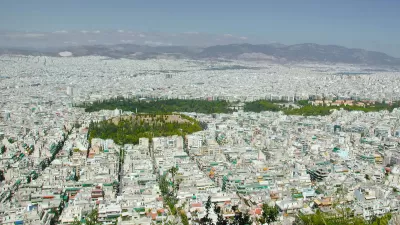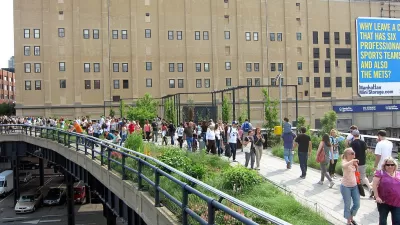Now it’s Jane’s turn.
Now it's Jane's turn.
Earlier this year, New York was abuzz with a series of exhibitions put on by Columbia University, the Museum of the City of New York, and the Queens Museum: "Robert Moses and the Modern City," with a subtitle noting the "transformation of New York," in contrast to the "fall" of New York in the subtitle of Robert Caro's epic biography The Power Broker. The series was a fresh look at the master builder, and suggested, implicitly and otherwise, that maybe Moses wasn't as terrible as he was made out to be, particularly in Caro's tome. Some of the dialogue that emerged centered on the question of whether the pendulum of community participation had swung too far, and the need for someone with Moses' vision if not another Robert Moses, to push for big projects and critical infrastructure to keep New York an economic powerhouse and a good place for people to live.
Now comes "Jane Jacobs and the Future of New York," a two-room multimedia exhibit at the Municipal Art Society -- 457 Madison Avenue, New York NY, opening Tuesday Sept. 28 and running through Jan. 5, 2008 (www.mas.org). The exhibit is sponsored by the Rockefeller Foundation, the same folks who gave Jacobs a grant that enabled her to write The Death and Life of Great American Cities almost a half-century ago. There is no revisionism in this presentation, curated by George Washington University's Christopher Klemek. The message is that Jacobs was vindicated in her recommendations for short blocks, diversity and density, and a mix of uses; tenacious in taking on the planning establishment and officialdom to show them the errors of their ways -- and, critically, that all New Yorkers should feel empowered to question plans and projects in pretty much the exact same way today. For each of the battles that Jacobs took on – blocking traffic in Washington Square Park, fighting urban renewal in the West Village, and beating back the Lower Manhattan Expressway, all of which, in full disclosure, I will chronicle in my upcoming book on the clash of Jacobs and Moses being published next year by Random House -- the exhibit cites a battle happening right now in New York, over landfills, environmental justice and other assorted projects, and the neighborhood group that is engaged in the cause.
The Municipal Art Society, currently looking for new leadership and a clarified role in the civic affairs of New York, clearly seeks to empower and educate, and laudably, reach new audiences. The fact is a great many people don't know who Jane Jacobs was. A television producer, for example, told organizers that the exhibit and related panels and walking tours all sounded very interesting, but wanted to know if Ms. Jacobs would be leading any tours or speaking herself (she died last April). Thus, the first room of the exhibit is an introduction to Jacobs and primarily the principles of urbanism she espoused. In a nice touch, guests can look through a Lucite panel to a stretch of Madison Avenue outside, and consider the mix and massing of buildings, or the pulse of people on the sidewalks. (When I was there I was fixated by the artistry of a worker scoring some freshly laid cement on the sidewalk along 51st Street, and had to tear myself away – but it was all in keeping with Jacobs' admonition to observe and look closely at the urban environment).
The second room dwells more on taking on the establishment, and includes a wonderful section of nasty letters about Jacobs from two men, Moses and Lewis Mumford. The fight against the plan to raze 14 blocks in the West Village circa 1961 gets thoughtful treatment; this is the area of Klemek's greatest expertise. Jacobs, during this time, developed a no-compromise approach and dabbled in trying to do housing development herself, with the West Village Houses, the 5-story red-brick alternatives to the towers in the park that Jacobs and the community managed to build near the Hudson River. The fight against the Lower Manhattan Expressway, which Moses wanted to build to connect the Holland Tunnel to East River crossings, is made vivid by a digital composition photograph showing a graffiti-strewn elevated highway structure – it looks like the Bruckner – plunked down in the middle of trendy Broome Street in SoHo. On the way out, visitors see a photograph of Jacobs in jail with Susan Sontag after being arrested in an anti-Vietnam War protest, and the quote from Jacobs on she resented how much time she had to spend fighting government plans when she says she would have been happier writing books.
The exhibit, which relies heavily on the contents of the Jane Jacobs papers at the Burns Library at Boston College, suffers somewhat from imprecision; the wrong date is given for her arrival in Greenwich Village, and the idea of putting a sunken roadway through Washington Square Park is misattributed to Moses (the man behind the submersion was Manhattan borough president Hulan Jack, whom Moses pilloried for daring to suggest an alternative to his surface-level park-piercing). The photo caption in a magazine showing Jacobs with various planning and design luminaries at the University of Pennsylvania in 1958 misidentifies the legendary urban and environmental scholar Ian McHarg as "Ian McHard," and the mistake is repeated in the exhibit copy. There are also a few typos that suggest a sense of being rushed.
Do we need another Moses? Did he do good things? This tribute to Jane Jacobs was seen by some as a kind of retort to the Moses exhibits, almost as if it was audacious to suggest that Jacobs' primary foil might be redeemed. No, actually, she was right and he was mostly wrong; she had an intuitive sense of what makes a successful city and Moses and the planners of the day didn't; she had the gumption to challenge authority, and all New Yorkers should engage in the future of their city with her energy and verve – those are some of the messages visitors to the Municipal Art Society may take away. How can big plans and big projects and infrastructure co-exist with community participation? Has NIMBYism led to paralysis that threatens to turn the city into a museum? How can affordability stay marbled into the urban neighborhoods that Jacobs knew the wealthy, in droves, would begin to value? Those are some of the trickier questions raised in the juxtaposition of Jacobs and Moses that are left open to discussion.
The exhibit will be accompanied by a series of panels and guided walking tours, the first of which was today through the Greenwich Village neighborhood Jacobs called home.

Planetizen Federal Action Tracker
A weekly monitor of how Trump’s orders and actions are impacting planners and planning in America.

Chicago’s Ghost Rails
Just beneath the surface of the modern city lie the remnants of its expansive early 20th-century streetcar system.

San Antonio and Austin are Fusing Into one Massive Megaregion
The region spanning the two central Texas cities is growing fast, posing challenges for local infrastructure and water supplies.

Since Zion's Shuttles Went Electric “The Smog is Gone”
Visitors to Zion National Park can enjoy the canyon via the nation’s first fully electric park shuttle system.

Trump Distributing DOT Safety Funds at 1/10 Rate of Biden
Funds for Safe Streets and other transportation safety and equity programs are being held up by administrative reviews and conflicts with the Trump administration’s priorities.

German Cities Subsidize Taxis for Women Amid Wave of Violence
Free or low-cost taxi rides can help women navigate cities more safely, but critics say the programs don't address the root causes of violence against women.
Urban Design for Planners 1: Software Tools
This six-course series explores essential urban design concepts using open source software and equips planners with the tools they need to participate fully in the urban design process.
Planning for Universal Design
Learn the tools for implementing Universal Design in planning regulations.
planning NEXT
Appalachian Highlands Housing Partners
Mpact (founded as Rail~Volution)
City of Camden Redevelopment Agency
City of Astoria
City of Portland
City of Laramie





























